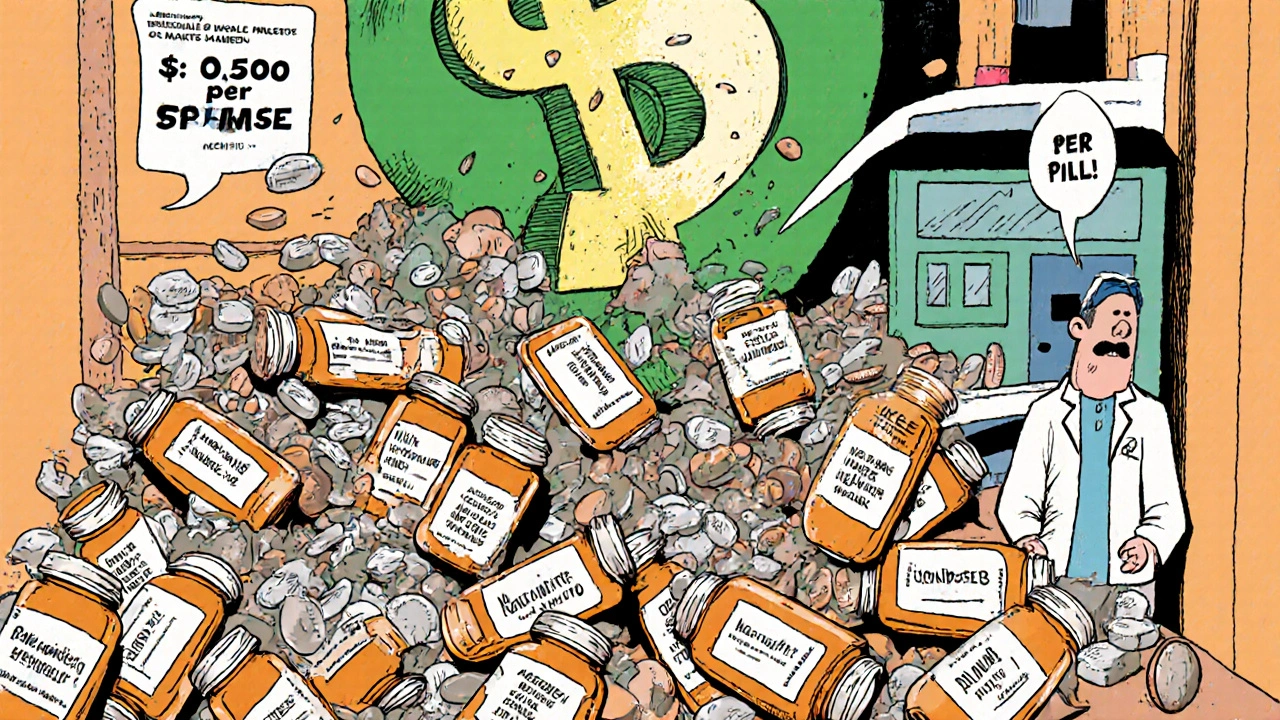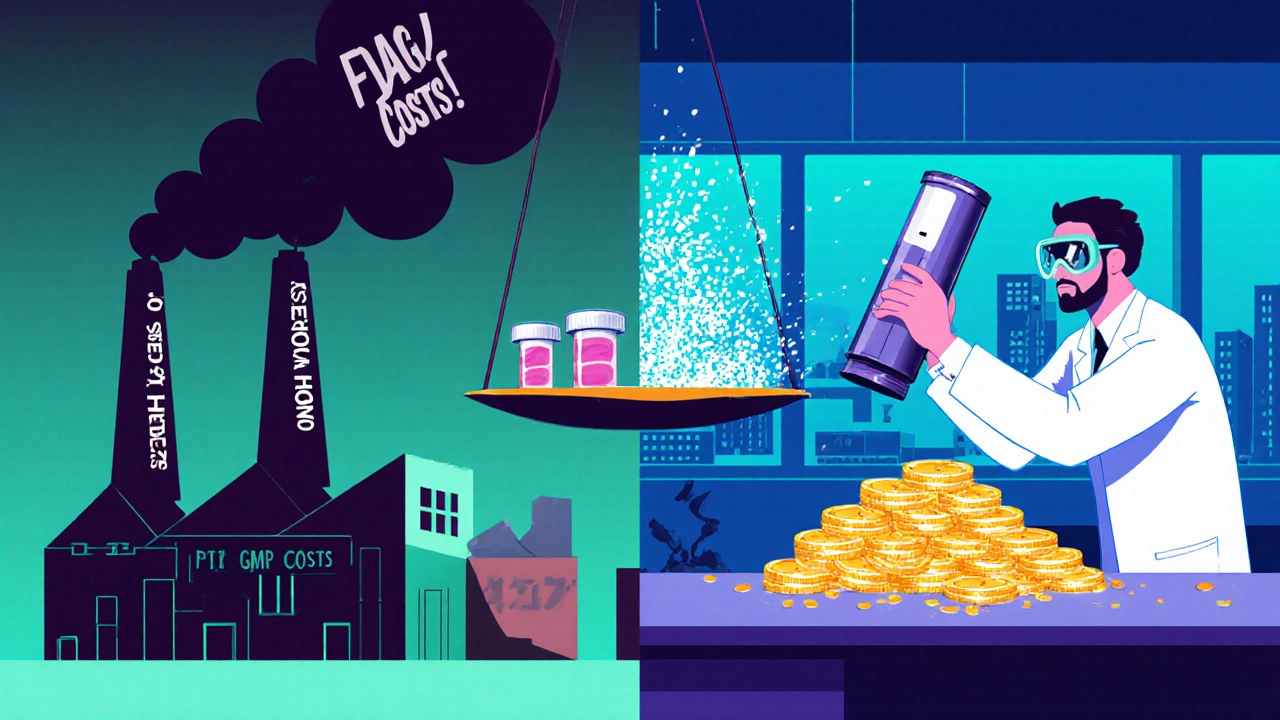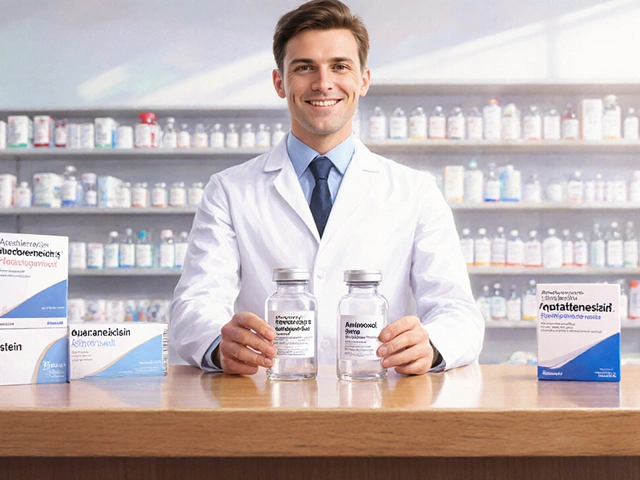
Generic drugs make up 90% of prescriptions in the U.S., but they only cost 10% of what brand-name drugs do. That’s a win for patients - and for the healthcare system. But for the companies making these drugs, it’s a different story. Many are losing money. Some barely break even. And if you’re wondering how any business survives in this environment, you’re not alone.
The Profitability Crisis in Generic Drugs
In 2025, Teva, one of the world’s largest generic drug makers, lost $174.6 million. That’s not a typo. They made $3.8 billion in sales but ended up in the red. Meanwhile, smaller players like Viatris - formed from the merger of Mylan and Upjohn - managed a 4.3% profit margin on $125 million in revenue. Why the gap?
The problem isn’t demand. It’s price. When a brand-name drug’s patent expires, dozens of manufacturers jump in to make the same pill. The result? A race to the bottom. A simple generic antibiotic that once sold for $10 a bottle now sells for $0.50. Some pills cost less than a coffee. Manufacturers are squeezed between falling prices and rising costs - FDA approval fees average $2.6 million per drug, and building a compliant factory can cost over $100 million.
Back in the 2000s, generic makers enjoyed 50-60% gross margins. Today, it’s common to see margins below 30%. And when you’re making pennies per pill, even a small supply chain hiccup - like a raw material shortage or a delayed FDA inspection - can wipe out your profit.
Three Business Models Trying to Survive
Not all generic manufacturers are failing. Some are adapting. Three models are emerging as the industry reshapes itself:
- Commodity generics - the old way. Making simple, high-volume drugs like metformin or lisinopril. Low barriers to entry. High competition. Thin margins. This model is collapsing under its own weight.
- Complex generics - the new lifeline. These aren’t just pills. They’re inhalers, injectables, topical gels, or combination drugs that are hard to copy. Think of a generic version of a branded asthma inhaler. It requires precise particle sizing, special packaging, and advanced formulation. Only a handful of companies can do it. That’s why margins here can hit 40-50%.
- Contract manufacturing - the quiet winner. Instead of selling their own brands, these companies make drugs for others. Branded companies outsource production to avoid building their own factories. Generic firms become service providers. This segment is growing at nearly 10% a year and is projected to hit $91 billion by 2030.
Teva is shifting toward complex generics. In 2024, they spent $998 million on R&D - up 5% - focusing on hard-to-make drugs like lenalidomide for multiple myeloma and Austedo XR for movement disorders. Their revenue grew 4% last year, despite the broader market shrinking. Viatris took a different path: they sold off their biosimilars unit and their OTC brand, and focused on what they do best - distributing proven generics at scale.

Why New Entrants Keep Failing
If this sounds like a good opportunity, think again. The barriers are brutal.
First, you need FDA approval. Each application - called an ANDA - costs $2.6 million on average. And it’s not just money. The paperwork takes 18-24 months. You need a cGMP-certified facility. You need to prove your drug is identical to the brand. You need to get on hospital formularies. And you need to compete against companies that already have relationships with pharmacy benefit managers (PBMs).
McKinsey found that over 65% of new companies focused only on commodity generics fail within three years. They run out of cash before they get their first order. Even if they get approved, they’re often forced to sell at a loss just to get shelf space.
And then there’s the “pay for delay” problem. Big pharma sometimes pays generic makers to hold off on launching their version of a drug. These deals - legal until recently - kept prices high for brand-name companies and choked off competition. Analysts estimate banning them could save the U.S. healthcare system $45 billion over 10 years. But for generic makers, it’s a double-edged sword. These deals kept some companies afloat. Now, they’re gone - and so is the cushion.
Regional Differences Matter
The U.S. isn’t the whole story. In Europe, generic drug prices are regulated differently. Reimbursement systems don’t force the same price wars. As a result, margins are higher - sometimes double those in America.
In emerging markets like India and Brazil, demand is growing fast. But there’s a catch: currency swings, unstable regulations, and weak intellectual property enforcement make it risky. Indian companies like Cipla and Sun Pharma have thrived here by building low-cost manufacturing and exporting to the U.S. and Europe. But even they’re moving up the value chain - investing in complex generics and specialty formulations.
North America still leads in contract manufacturing volume, but Asia-Pacific is catching up fast. Companies like Egis Pharmaceuticals in Hungary have launched dedicated contract services arms, offering API development and manufacturing to global clients.

What’s Next? The Path to Sustainability
Generic drugs aren’t going away. In fact, over 16,000 are on the market today - and more are coming. Dozens of blockbuster drugs - including Humira, Eliquis, and Keytruda - will lose patent protection between 2025 and 2033. That’s a $600 billion opportunity by 2033, according to industry forecasts.
But only companies that stop competing on price alone will survive. The winners will be those who:
- Invest in complex formulations - not just pills, but delivery systems that are hard to copy
- Build partnerships with branded firms as contract manufacturers
- Focus on niche markets - like pediatric generics or drugs for rare diseases
- Use automation and AI to cut production costs and improve quality control
There’s no magic fix. But there’s a clear direction. The industry is moving from a commodity business to a technical one. It’s no longer about making the cheapest tablet. It’s about making the most reliable, hardest-to-replicate version of a drug - and doing it at scale.
Patients win when drugs are affordable. But if manufacturers can’t make money, they stop making them. And that’s when shortages happen. In 2024, over 300 generic drugs were in short supply in the U.S. - many of them essential antibiotics, heart medications, and anesthetics. The reason? No one could profitably produce them.
So the real question isn’t whether generics can be profitable. It’s whether society is willing to pay enough - through smarter pricing, fairer contracts, and smarter regulation - to keep the lights on.
Can This System Last?
Some say the current model is broken. Dr. Aaron Kesselheim from Harvard calls it a market failure. Others, like Chip Davis of the Association for Accessible Medicines, believe the downturn is temporary. He points to the wave of expiring patents coming through 2033 as the industry’s next big chance.
The truth is somewhere in between. The old way - flood the market with identical pills and compete on price - is dead. The new way requires skill, capital, and strategy. Companies that treat generics like a low-tech business will disappear. Those that treat them like a high-stakes engineering challenge will thrive.
Generic drugs saved the U.S. healthcare system over $408 billion in 2022 alone. That’s not a footnote. It’s the foundation of affordable care. But foundations need support. And right now, the people building them are running out of money.
Why are generic drug profits falling so fast?
Generic drug profits are falling because once a brand-name drug’s patent expires, dozens of manufacturers rush in to make the same product. This floods the market, forcing prices down. At the same time, costs for FDA approval, manufacturing compliance, and raw materials keep rising. Many companies now operate with gross margins under 30%, down from 50-60% in the 2000s.
What’s the difference between commodity and complex generics?
Commodity generics are simple, off-patent pills - like metformin or ibuprofen - made by dozens of companies. They’re cheap to produce but face extreme price competition. Complex generics involve harder-to-make drugs like inhalers, injectables, or combination therapies. These require advanced technology, specialized equipment, and deeper expertise. Because fewer companies can make them, margins are higher - often 40-50%.
Why are contract manufacturers doing better than brand generic makers?
Contract manufacturers don’t compete on price for their own brands. Instead, they provide manufacturing services to branded or generic companies that don’t want to build their own factories. This model avoids the race-to-the-bottom pricing of the generic market. Demand is rising as big pharma outsources production to cut costs, and the segment is projected to grow to $91 billion by 2030.
Is the U.S. the only market where generic profits are low?
No. The U.S. has the lowest margins due to its pharmacy benefit manager (PBM) system, which pressures prices aggressively. European markets have more stable pricing and reimbursement rules, so margins are higher. Emerging markets like India offer growth but come with regulatory and currency risks. Many Indian manufacturers now export complex generics to the U.S. and Europe to access better margins.
Will generic drugs become scarce if companies keep losing money?
Yes, and it’s already happening. Over 300 generic drugs were in short supply in the U.S. in 2024, including critical antibiotics and heart medications. When manufacturers can’t make a profit, they stop producing the drug - even if it’s essential. This creates dangerous gaps in patient care. The only way to prevent this is to ensure manufacturers can earn enough to cover costs and stay in business.
What’s the biggest opportunity for generic manufacturers today?
The biggest opportunity lies in complex generics and contract manufacturing. With over 50 major brand-name drugs set to lose patent protection between 2025 and 2033, there’s a huge wave of new products coming. Companies that invest in hard-to-make formulations - like extended-release tablets, biologics, or combination therapies - will capture the best margins. Contract manufacturing is also booming, as big pharma looks to outsource production.




